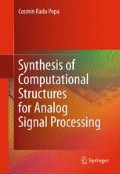Abstract
The Euclidean distance function is very important in instrumentation circuits, communication, neural networks, display systems or classification algorithms, useful for vector quantization or nearest neighbor classification. In order to obtain a good frequency response, the Euclidean distance circuits are implemented using exclusively MOS transistors working in saturation. Depending on their input variable, the Euclidean distance circuits can be classified in computational structures having current-input or voltage-input vectors.
Access this chapter
Tax calculation will be finalised at checkout
Purchases are for personal use only
References
Popa C (2009) A new FGMOST Euclidean distance computational circuits based on algebraic mean of the input potentials. In: Lecture notes in computer science, Springer, pp 459–466
Vlassis S, Fikos G, Siskos S (2001) A floating gate CMOS Euclidean distance calculator and its application to hand-written digit recognition. In: International conference on image processing, pp 350–353
Popa C (2004) FGMOST-based temperature-independent Euclidean distance circuit. In: International conference on optimization of electric and electronic equipment, pp 29–32
Popa C (2005) Current-mode Euclidean distance circuit independent on technological parameters. In: International semiconductor conference, pp 459–462
Vlassis S, Yiamalis T, Siskos S (1999) Analogue computational circuits based on floating-gate transistors. In: International conference on electronics, circuits and systems, 5–8 Sept 1999, pp 129–132
Popa C (2003) Low-voltage accurate CMOS threshold voltage extractors. In: IEEE-EURASIP workshop on nonlinear signal and image processing, Trieste, Italy (only CD)
Popa C (2004) CMOS current-mode Euclidean distance circuit using floating-gate MOS transistors. In: International conference on microelectronics, 16–19 May 2004, pp 585–588
Netbut C, Kumngern M, Prommee P, Dejhan K (2006) A versatile vector summation circuit. In: International symposium on communications and information technologies, Bangkok, pp 1093–1096
Manolescu AM, Popa C (2009) Low-voltage low-power improved linearity CMOS active resistor circuits. Springer J Analog Integr Circuits Signal Process 62:373–387
Hyo-Jin A, Chang-Seok C, Hanho L (2009) High-speed low-complexity folded degree-computationless modified Euclidean algorithm architecture for RS decoders. In: International symposium on integrated circuits, Singapore, 14–16 Dec 2009, pp 582–585
Author information
Authors and Affiliations
Corresponding author
Rights and permissions
Copyright information
© 2012 Springer Science+Business Media, LLC
About this chapter
Cite this chapter
Popa, C.R. (2012). Euclidean Distance Circuits. In: Synthesis of Computational Structures for Analog Signal Processing. Springer, New York, NY. https://doi.org/10.1007/978-1-4614-0403-3_6
Download citation
DOI: https://doi.org/10.1007/978-1-4614-0403-3_6
Published:
Publisher Name: Springer, New York, NY
Print ISBN: 978-1-4614-0402-6
Online ISBN: 978-1-4614-0403-3
eBook Packages: EngineeringEngineering (R0)

